Dillon Read (14): "You are Going to Prison" - 1996
A Serialised Story - Part 14 of 20 (publishing August/September 2007)
Dillon Read & Co. Inc.
And the Aristocracy of Stock
Profits
By Catherine Austin
Fitts
Click Here For Links To Other
Chapters
http://www.scoop.co.nz/stories/HL0708/S00302.htm#2
Chapter 13: “You are Going to Prison” — 1996
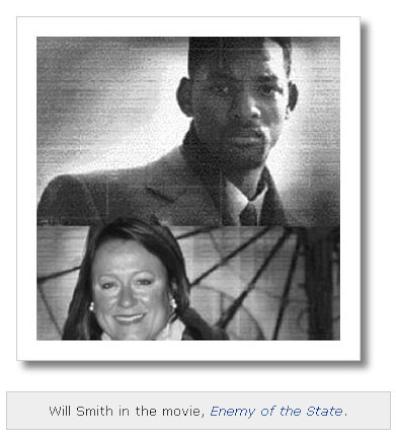
Though a fictional movie, Enemy of the State with Will Smith and Gene Hackman shows how targeting a person works in Washington, D.C. Will Smith plays a Washington lawyer who is targeted in a phony frame-and-smear campaign by U.S. intelligence agency personnel who are afraid that he has evidence of their assassination of a Congressman. The spook types have high-speed access to every last piece of data on the information highway — from Will's bank account, to his telephone conversations, to his exact location — and the wherewithal to destroy his career and threaten his life. The organizer of an investment conference once introduced me by saying, "Who here has seen the movie Enemy of the State? The woman I am about to introduce to you played Will Smith's role in real life."
One day I was a wealthy entrepreneur with a beautiful home, a successful business and money in the bank. The next day I was hunted, business assets seized, living through some eighteen audits and investigations, a smear campaign directed not just at me but also members of my family, colleagues and friends who helped me, and nine years of highly personalized litigation against The Hamilton Securities Group. For many years, I and those helping me lived with serious physical harassment and surveillance at the hands of mostly unseen, dark forces. Events such as home break-ins, stalking, poisonings, having houseguests followed, friends, colleagues and family warned to not associate with me, a dead animal left on the doormat, and worse became commonplace.[59]
The problems started at the end of 1995 and relentlessly evolved into significant investigation and litigation in 1996.[60] Both frontal and covert attacks came in waves that made no sense to me until we started to map out in chronological form the parallel efforts to suppress Gary Webb’s "Dark Alliance" story, and the timing of stock market profit taking by investors in HUD property managers and private prison companies such as Cornell Corrections. There was a war going on for the rich corporate cash flows determined by the federal budget — between those who made money on building up of communities and a peace economy, and those who made money on the failure of communities and a war economy. As stock market prices and the Dow Jones Index rose, this economic warfare grew in fierceness. For example, a comparison of how DOJ handled The Hamilton Securities Group — a firm that helped communities succeed — versus how it dealt with Enron — a company that criminally destroyed retirement savings and communities — underscores much about the system's true intentions.[61]
In March 1995, the first billion-dollar HUD loan sale was a significant success. The performance stunned both traditional HUD constituencies and Wall Street. Barron's published an article, “Believe It or Not, HUD Does Something Right for Taxpayers” (Jim McTague, April 10, 1995). Many were caught off guard by the success of the sale, including the prices that resulted from the combined ingenuity of the investment banking and software technology involved. It established the team at FHA, with The Hamilton Securities Group as lead financial advisor, as significant leaders in authentic reengineering, as opposed to what sounded to me like the press release reengineering coming from Al Gore and Elaine Kamarck’s Office of Reinventing Government.
A hint of the trouble to come was the response from Mike Eisenson, head of the Harvard Endowment’s private equity portfolio. Mike, later to become known for his role in financing George W. Bush's oil company, Harken Energy, was responsible for Harvard's investment along with Harvard board member Dyn Corp Chairman Pug Winokur in National Housing Partnerships (NHP), one of the largest HUD property management companies. As we were preparing to bid the first billion dollar loan sales, Mike picked up his phone when I called him and said to me “Fuck you!” He then proceeded to explain that he hated our bidding process — the only way Harvard could win was by paying more money than the other bidders. One of the reasons that this was a problem was that NHP would be forced to compete for its defaulted mortgages and would be held to market standards on property management fees or would lose management business on properties where HUD transferring the mortgage gave the new owner the right to transfer the property management. NHP was said to be Mike's single biggest investment. To sell it at a profit, he needed to do NHP to do an IPO. That meant NHP needed more government insider deals, not less.
The bid process I had created was pitting large and small real estate, mortgage and securities investors against each other in a manner that significantly increased competition relative to traditional bidding practices. This resulted in HUD attracting significant new investment interest in buying their defaulted mortgages and significantly higher recoveries on those mortgages. As a result, in approximately $10 billion of loan sales lead by The Hamilton Securities Group, HUD was able to generate $2.2 billion in savings to the FHA Fund. Later audits confirmed that the loan sales had a positive impact for communities in which the properties were located.
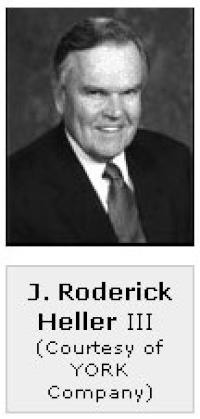 One of the many
ironies of the loan sales was that J. Roderick Heller III,
Chairman and CEO of NHP had asked me to start Hamilton to
serve as lead investment bank to NHP. When I joined Rod and
Mike at the Harvard Club in the early 1990's to sign the
contract, they tried to significantly change the terms of
the deal and essentially abrogated Rod's verbal contract. If
we had proceeded to help NHP as originally planned, we would
not have served as lead financial advisor to HUD/FHA. If the
Harvard private equity group resented us helping the
government regulator of the largest investment in their
portfolio, they had no one to blame but
themselves.
One of the many
ironies of the loan sales was that J. Roderick Heller III,
Chairman and CEO of NHP had asked me to start Hamilton to
serve as lead investment bank to NHP. When I joined Rod and
Mike at the Harvard Club in the early 1990's to sign the
contract, they tried to significantly change the terms of
the deal and essentially abrogated Rod's verbal contract. If
we had proceeded to help NHP as originally planned, we would
not have served as lead financial advisor to HUD/FHA. If the
Harvard private equity group resented us helping the
government regulator of the largest investment in their
portfolio, they had no one to blame but
themselves.
Another indication of the trouble to come was that I started to receive bizarre e-mails from Tino Kamarck, the husband of Elaine Kamarck who ran Gore's Office of Reinventing Government at the White House. I had met Tino, who was then #2 at the Export Import Bank and later to be Chairman, when he worked on Wall Street but did not know him well. Out of the blue and by e-mail, he expressed extraordinary and inaccurate notions of my lifestyle and personal habits and proposed that he and I have an affair. I suspected at the time that he had ulterior motives. Sex in Washington, D.C. rarely has anything to do with sex — it’s usually about dirty tricks and dirty politics. One of the inspirations for my starting my own firm had been twenty minutes of listening to Jack Kemp, Secretary of HUD while I was Assistant Secretary, order me to lengthen my skirts. This meeting had nothing to do with my skirts. I suspected that it was an unsuccessful attempt by Jack to get me to lose my temper. I was running the FHA money too cleanly. Despite my offer to move elsewhere in the Administration, Jack preferred to force me out in a manner that could be blamed on me.
To give a sense of the interconnectedness of things, one of our problems appeared to be Jonathan Kamarck, who was on staff in the Senate appropriations subcommittee that was such a significant supporter of HUD’s Operation Safe Home and was uncomfortable with the impact of the HUD loan sales on traditional real estate interests. Jonathan told me that he was Tino’s cousin and so presumably was close to both Tino and Elaine Kamarck. By the time the allegations against The Hamilton Securities Group were discredited and Harvard Endowment had reaped large profits cashing out of their HUD related investments, Elaine was working for Harvard and Tino was working for a real estate firm in Boston that had intimate ties with Harvard and had managed to snag a contract with HUD to do some of the work that The Hamilton Securities Group had been doing. Years later I visited with one of Jonathan’s colleagues on the Senate appropriations subcommittee who had been promoted to chief of staff to the subcommittee chair, Senator Kit Bond, who expressed concern that “HUD was being run as a criminal enterprise.” When only months later the subcommittee engineered a large increase in HUD’s appropriations, I was reminded of what Bill Moyers, former White House Press Secretary, had said on the CIA’s alliance with the Mafia, “Once we decide that anything goes, anything can come back to haunt us.”
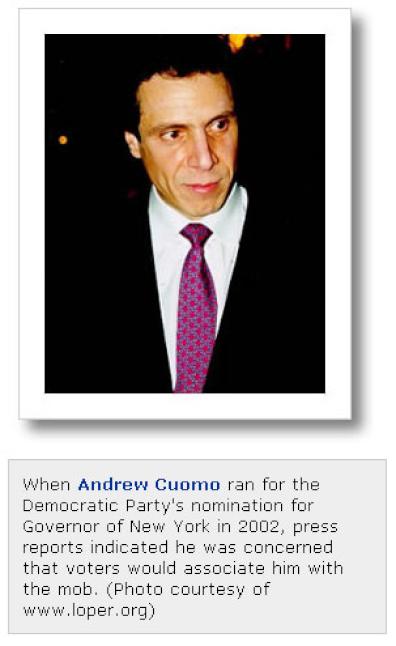
The politics took a serious turn when someone from the HUD Inspector General’s Office reported that they were in a meeting with Andrew Cuomo, then Assistant Secretary of Community Development at HUD and soon to be Secretary, and the HUD Inspector General Susan Gaffney. Cuomo reported that he was arranging to get rid of The Hamilton Securities Group and me. Cuomo was considered to be very close to Al Gore and his White House office and efforts to “reengineer government.” Within months, it was reported to me by Nic Retsinas, then Assistant Secretary of Housing, that the White House had ordered him not to hire The Hamilton Securities Group on the next round of contracts — an order which he said he ignored. Later, an associate of the Assistant Secretary of Administration, the appointee who oversees the contracting HUD office, reported to me the same White House orders.
Notwithstanding the orders from on high to the contrary , in January and April of 1996 a new HUD/FHA contract and task order were awarded to The Hamilton Securities Group under which HUD was to pay Hamilton a base of $10 million a year for two years to serve as the FHA’s lead financial advisor. Our successes — from profitable HUD/FHA contract awards to analysis generated by software and database innovations that had Alan Greenspan asking for briefings from our analytics team for the Federal Reserve staff—was a surprise to some who had thought our commitment to technology would not make a significant difference in marketplace transactions and bottom line dollars and sense.
This was a period of risk and transition for many. Dillon Read and John Birkelund were recovering from the unexpected failure of the firm's lead investor, Barings. After helping the Dillon partners buy the firm back from Travelers in 1991, Barings had collapsed as the result of an Asian trading scandal in early 1995. With Dillon as lead investors, Cornell Corrections was losing money. Former Dillon Chairman and Treasury Secretary, Nick Brady, was learning about the difficulties of starting up his own firm, Darby Overseas Investments, Ltd, in Washington, D.C. The Clinton team was wondering what would happen to them if the Republican takeover of Congress in the 1994 elections translated into their being thrown out in the 1996 elections. Mike Eisenson's compensation was constrained by publicity regarding salaries paid by Harvard Management and only later was he inspired to start his own firm (with — imagine this — a contract from Harvard Management that paid $10 million a year — the same as The Hamilton Securities Group’s HUD contract.) One can only wonder what was going on behind the scenes at the CIA and DOJ after the Memorandum of Understanding was rescinded in August 1995. Presumably, the rescission left the CIA obligated to report all narcotics trafficking to DOJ and required DOJ to see to it that the CIA satisfied such obligations. Hence, any transparency of the kind that Hamilton was creating with its software tools could significantly increase the criminal liabilities of CIA, DOJ and their contractors. When people are afraid or managing rising risk, they are sometimes jealous of a start-up’s success and frustrated by their inability to openly insist that newcomers respect traditional market relationships, let alone illegal, covert lines of authority and cash flows.
In the late spring of 1996, I had dinner at a National Housing Conference event with Scott Nordheimer, a HUD developer who had been pursuing business with DOJ’s Federal Bureau of Prisons. Scott had recently gotten out of prison as a result of a securities fraud conviction and believed that the future for our data servicing business was in prisons. He tried very aggressively to persuade me that the opportunities in prisons were significant — in contrast to the job-creating opportunities of our community-based model, which he said would not be "politic." When I declined Scott's invitations to meet with the Federal Bureau of Prisons, I suspect that he went ahead and gave DOJ our data servicing business plan. He was soon to become very successful in HUD’s Hope VI program. This was a matter of some controversy as HUD was forcing out tenants who had a felony record while allowing the building to essentially be owned and managed by partnerships with a convicted felon in the lead.[62]
At the dinner in the late spring of 1996, Scott looked quite pleased with himself and explained that a decision had been made to frame me and that I was in serious trouble. He said, “Well, we tried to have you fired through the White House but that did not work, so now the big boys have gotten together and [decided] you are going to prison.”
The other board members of The Hamilton Securities Group and myself had been extremely careful in the way that we had built and managed the company. We had seen other firms targeted with government dirty tricks and had done everything in our power to ensure that we could withstand corrupt audits and trumped-up, political investigations. I responded to Scott’s dire predictions, “It will never work, Scott. We are too clean.” Scott replied, “You don’t get it. The fix is in. There is nothing you can do.” That was the first time I sensed that it was a matter of great personal desire for some one or group to see me in a prison cell and that some aspect of this was personal.
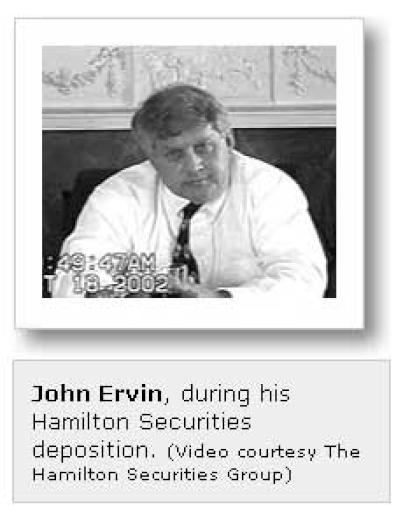
On August 6, 1996, Hamilton received the first subpoena in what became years of subpoena warfare by the HUD Inspector General (investigating under delegated authority by DOJ.) At the time, I did not know that DOJ was holding secret hearings in Federal district court as a result of a qui tam filing in June 1996 by Ervin & Associates, in which Hamilton was falsely accused of civil and criminal violations. The investigation was conducted under the pretext of a “qui tam lawsuit” — a lawsuit brought by a private party as a bounty hunter for the government looking to make 15-30% of the government "damages" (which could be trebled) recovered from a private party found to have made "false claims" against the government. The delegation of subpoena authority to HUD was used by the government to circumvent the requirement to disclose this to the targets of the qui tam, including The Hamilton Securities Group
Ervin & Associates was founded by John Ervin, a former employee of Harvard's HUD property management company, NHP. Ervin had won contracts to service defaulted and coinsured HUD mortgages and in 1994 won a contract to collect financial statements for HUD-supported apartment buildings. Through these contracts, Ervin had a rich flow of data on HUD-assisted and -financed, privately-owned apartment buildings. In a later deposition, Ervin testified that he was able to refer cases worth many millions of dollars for civil money penalties to the HUD OIG. In short, he claimed to be a part of the profit-making business of the HUD OIG ’s Operation Safe Home. As HUD disposed of more and more mortgages through the loan sales, Ervin's business diminished. Presumably, at some point, this may have diminished his ability to generate profitable leads and revenues for HUD OIG.
The first subpoena was the beginning of a two-year period during which I was not allowed to know of the existence of the qui tam lawsuit that resulted in the destruction of my company and a four-year period during which I was not allowed to read or hear the allegations made against my company and me or know who made them. It was five years before I had access to transcripts of sealed court hearings (unattended by me or my counsel, of course) in the qui tam case. It was seven to eight years before Ervin and the government were required to put forward evidence attempting to support their baseless claims and before The Hamilton Securities Group and our attorneys had the opportunity to refute the false charges in a court of law sufficient to shut down the smear campaign being used against me as an investment banker in the market place. Throughout this period, both the HUD Inspector General and private parties shared bits and pieces of the supposedly sealed allegations repeatedly with both the press and members of Congress.
Jack Kemp announced his candidacy for Vice President on August 10th. Gary Webb's "Dark Alliance" story broke in the San Jose Mercury News eight days later.
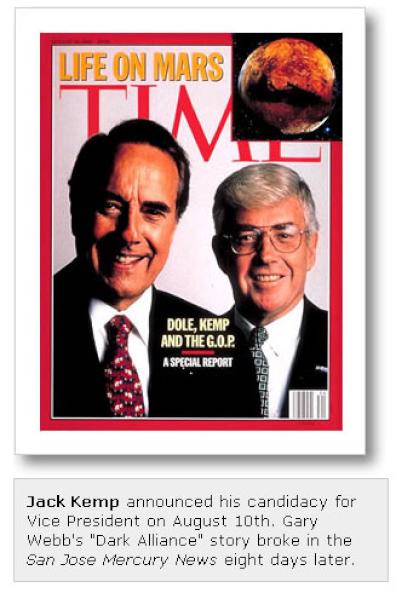
Four days after we received our first subpoena, on August 10th, 1996, Jack Kemp, the Secretary of HUD when I was Assistant Secretary, announced he was the Republican candidate for Vice President. Jack was considered someone who would be effective at persuading women and minorities to support the Republican ticket. The reality of Kemp’s real philosophies and history were much darker and much less inclusive. Initially at the request of my attorneys, I was later to document some of my experiences with Kemp's darker underside, including his efforts to provide subsidies illegally to a project reported to be developed by Andrew Cuomo when Andrew was an attorney in New York helping to raise money for his father, Mario Cuomo, then the Governor of New York.[63]
Eight days later, on August 18th, 1996, Gary Webb’s "Dark Alliance" story broke in the San Jose Mercury News implicating the CIA and, ultimately, DOJ in complicity to traffic in narcotics. This narcotics trafficking had occurred during the Iran-Contra period when Bush was Vice President and Oliver North as staff were in charge of the National Security Council. Bush’s close friend and supporter Nick Brady and partner John Birkelund at Dillon Read were leading investment banking for RJR Nabisco, which according to the European Union was complicit in laundering significant profits for global narcotics cartels and mafia at this time. Bill Clinton was Governor and Hillary Clinton was a partner at the Rose Law firm in Arkansas where a portion of the revenues from the Mena operation were allegedly laundered through the state housing agency. The very same Arkansas agency was ultimately governed by Governor Clinton and served as bond counsel by the Rose Law Firm. Stanley Sporkin at that time was serving as the General Counsel of the CIA while the now-infamous Memorandum of Understanding with DOJ was crafted. If you follow the likely cash flows in and out of the alleged Mena and Arkansas state housing bond operations and the alleged narcotics trafficking and HUD mortgage defaults in South Central Los Angeles, and the allegations surrounding the events and subsequent cover ups, there was an uncomfortable closeness of networks between those in Webb’s story and those in power.
I had not read or heard about the “Dark Alliance” allegations at the time. An expression of the extraordinary compartmentalization of our society, the members of my team who later confided that they had been aware of the story, had not mentioned it to me. They did not see the connection between the threat posed by our leadership in reengineering government or providing community access to software tools and databases about federal resources by place, and government complicity in narcotics trafficking and related HUD fraud alleged to be laundering the proceeds.
I was buried in the workload avalanche of running a company while dealing with subpoenas and a smear campaign unleashed initially by a team of reporters from U.S. News & World Report. I did not notice in early October when the Washington Post published the “results” of its “independent” investigation into Gary Webb’s allegations, saying that there was insufficient evidence to support Webb’s claims. I was also unaware that while the White House was trying to have my contracts ended, Elaine Kamarck in Vice President Al Gore’s Office at the White House was busy working with DOJ Deputy Attorney General Jamie Gorelick to make sure that the private prison industry was blessed with oodles of contracts.
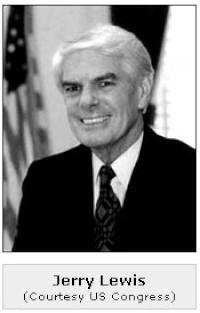 While I and my
colleagues endured multiple subpoenas and smear campaigns
and Gary Webb was in the process of defending his story at
the San Jose Mercury News (later to lose his job the
following year), Dillon Read filed a registration statement
with the SEC for Cornell’s initial public offering on July
17th, amending it on August 26th, September 10th, and
September 30th with a final prospectus filed on October 4,
1996. This was good news for Dillon Read and its investors.
Thanks to the successful efforts of the Clinton
Administration to pass new crime legislation and ensure DOJ
bureaucracy support for outsourcing contracts to run federal
prisons to private prison companies — including a gush of
contracts to Cornell from the fall of 1995 to the spring of
1996 — Dillon Read’s Cornell stock purchased at an
average price between $2-3 per share, was now worth $12 a
share, a 400–600% increase. In addition to their stock
profits, Dillon pocketed big underwriting fees as well as
the lead investment bank arranging the stock offering. In
nine months, the Clinton Administration’s increase in
contracts and acquisition of entities with contracts
supporting 1,726 prisoners had literally made the company.
The IPO reflected a stock market valuation of $24,241 per
prisoner. What that means is that every time HUD’s
Operation Safe Home dropped swat teams into a community and
rounded up 100 teenagers for arrest, the potential value to
the stockholders of the prison companies that managed the
juvenile facilities and prisons was $2.4 million. Operation
Safe Home could easily afford to do so as a result of
significant increases in appropriations arranged that summer
and fall through the HUD IG Susan Gaffney's biggest
congressional supporters -- Jerry Lewis (Republican-San
Bernadino, California), Chairman of the House appropriations
committee, and Senator Kit Bond (Republican-Missouri),
Chairman of the Senate HUD appropriations
subcommittee.
While I and my
colleagues endured multiple subpoenas and smear campaigns
and Gary Webb was in the process of defending his story at
the San Jose Mercury News (later to lose his job the
following year), Dillon Read filed a registration statement
with the SEC for Cornell’s initial public offering on July
17th, amending it on August 26th, September 10th, and
September 30th with a final prospectus filed on October 4,
1996. This was good news for Dillon Read and its investors.
Thanks to the successful efforts of the Clinton
Administration to pass new crime legislation and ensure DOJ
bureaucracy support for outsourcing contracts to run federal
prisons to private prison companies — including a gush of
contracts to Cornell from the fall of 1995 to the spring of
1996 — Dillon Read’s Cornell stock purchased at an
average price between $2-3 per share, was now worth $12 a
share, a 400–600% increase. In addition to their stock
profits, Dillon pocketed big underwriting fees as well as
the lead investment bank arranging the stock offering. In
nine months, the Clinton Administration’s increase in
contracts and acquisition of entities with contracts
supporting 1,726 prisoners had literally made the company.
The IPO reflected a stock market valuation of $24,241 per
prisoner. What that means is that every time HUD’s
Operation Safe Home dropped swat teams into a community and
rounded up 100 teenagers for arrest, the potential value to
the stockholders of the prison companies that managed the
juvenile facilities and prisons was $2.4 million. Operation
Safe Home could easily afford to do so as a result of
significant increases in appropriations arranged that summer
and fall through the HUD IG Susan Gaffney's biggest
congressional supporters -- Jerry Lewis (Republican-San
Bernadino, California), Chairman of the House appropriations
committee, and Senator Kit Bond (Republican-Missouri),
Chairman of the Senate HUD appropriations
subcommittee.
 All that was needed
for prison privatization to work was the suppression of
truth — about who was really bringing in the drugs and why
it was essential for citizens to not see or understand the
real deal on “how the money worked” in the places in
which they lived and worked. If there had been a map of the
real deal about how the money works in communities and in
government, along the lines of the software being developed
by Hamilton when the qui tam lawsuit put us out of business,
the private prison industry might not have gotten off the
ground. If one were to document the true criminality or the
true economic waste within the system, it was pretty
apparent that the real criminals and the real financial
drain were not the kids being rounded up by HUD’s
Operation Safe Home and not the owners and employees of The
Hamilton Securities Group.
All that was needed
for prison privatization to work was the suppression of
truth — about who was really bringing in the drugs and why
it was essential for citizens to not see or understand the
real deal on “how the money worked” in the places in
which they lived and worked. If there had been a map of the
real deal about how the money works in communities and in
government, along the lines of the software being developed
by Hamilton when the qui tam lawsuit put us out of business,
the private prison industry might not have gotten off the
ground. If one were to document the true criminality or the
true economic waste within the system, it was pretty
apparent that the real criminals and the real financial
drain were not the kids being rounded up by HUD’s
Operation Safe Home and not the owners and employees of The
Hamilton Securities Group.
Always ready with the best of spin, Hillary Clinton published It Takes a Village in September while Bob Rubin, as Secretary of Treasury (at this writing a senior executive in the Office of the Chairman at Citigroup), talked about the importance of economic development in the inner city. Rubin’s former firm, Goldman Sachs, one of the largest bidders on the HUD loan sales, had been one of the largest investment bankers in Arkansas during the Mena period. Linda Ives was the courageous mother of an Arkansas teenager killed by police in August 1987 when he and a friend apparently accidentally encountered a cocaine drop at the Mena operation. Ives, working with journalist Mara Levitt, persisted in illuminating many of the events surrounding her son’s death — initially ruled a suicide — and the corruption in Arkansas.[64] Ives could tell us why it takes an entire village to raise a child when leaders like Hillary Clinton and Bob Rubin and their partners and colleagues are making money in the vicinity.
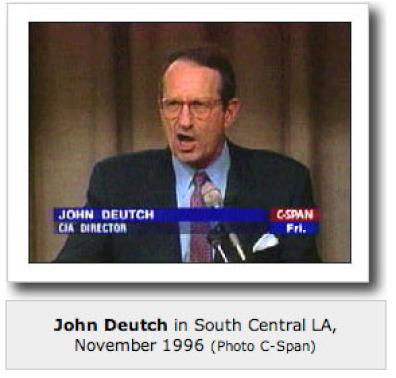
I have found that, just when things look their darkest, something happens that can transform the course of events. On November 15, 1996, CIA Director John Deutch was confronted with alleged evidence of CIA narcotics trafficking before a large audience of citizens and media cameras. Deutch was there to address Garry Webb’s "Dark Alliance" allegations — which described CIA complicity. The confrontation was later memorialized in the award winning online video by the Guerilla News Network, "Crack the CIA." Deutch stated on camera that Webb's allegations would be investigated by the CIA Inspector General, leading to Congressional hearings. Those hearings included the one right after Hamilton's office and records were taken over by the court.
It would take me two years of standing in the face of an onslaught of enforcement terrorism and terrifying physical harassment and surveillance before I was to see the videotape of that event and find and read Gary Webb's work. That was when I began the education through which I would come to understand why transparency of neighborhood financial flows was sufficiently threatening to the stability of the global financial system such that powerful interests might insist on the destruction of The Hamilton Securities Group and our software tools.
FOOTNOTES[59] For details on some of the specifics of modern day "crucifixions" see, Anatomy Of A SWAT From A Lawyer’s Perspective by Lucille Compton (http://www.scoop.co.nz/stories/HL0504/S00241.htm).
See The Swat List—Audits, Investigations, Inquiries, Leads, Conflicts of Interest, Harassment and Surveillance by The Hamilton Securities Group, Inc. (http://www.solari.com/gideon/legal/audits.html).
See The Professional Paranoid by H. Michael Sweeney (http://www.alibris.com/search/search.cfm).
[60] See Litigation section at Solari (http://www.solari.com/gideon).
[61] For a detailed comparison of DOJ’s handling of the investigation of Hamilton with the investigation of Enron, see The Real Deal About Enron: An Interview with Catherine Austin Fitts by Daniel Armstrong (http://www.scoop.co.nz/stories/HL0304/S00031.htm).
[62] See Common Denominator stories by John DeVault: Convicted swindler in city housing deals (http://thecommondenominator.com/052101_news1.html); DCHA tenants ask to manage complex (http://www.thecommondenominator.com/070201_news3.html); Metro miscue? (http://thecommondenominator.com/102201_news1.html).
[63] Kemp Tapes—Recollections of Working in Bush I by Catherine Austin Fitts (http://www.solariactionnetwork.com/phpBB2/viewtopic.php?t=269).
[64] See Boys on the Tracks by Mara Leveritt (http://www.amazon.com/gp/product/0312198418/103-5464626-9431002v=glance&n=283155&v=glance).
 Mapping The Real Deal is a column on
Scoop supervised by Catherine Austin Fitts. Ms Fitts is the
President of Solari, Inc. http://www.solari.com/. Ms. Fitts is
the former Assistant Secretary of Housing-Federal Housing
Commissioner during the first Bush Administration, a former
managing director and member of the board of directors of
Dillon Read & Co. Inc. and President of The Hamilton
Securities Group,
Inc.
Mapping The Real Deal is a column on
Scoop supervised by Catherine Austin Fitts. Ms Fitts is the
President of Solari, Inc. http://www.solari.com/. Ms. Fitts is
the former Assistant Secretary of Housing-Federal Housing
Commissioner during the first Bush Administration, a former
managing director and member of the board of directors of
Dillon Read & Co. Inc. and President of The Hamilton
Securities Group,
Inc.


 Keith Rankin: Geopolitical Fractures, And Untidy Yet Workable Solutions
Keith Rankin: Geopolitical Fractures, And Untidy Yet Workable Solutions Gordon Campbell: On Winston Peters’ Battle Against The Phantom Legions Of The Woke
Gordon Campbell: On Winston Peters’ Battle Against The Phantom Legions Of The Woke Adrian Maidment: Road Cone Final Exam & Donald, I Warned You!
Adrian Maidment: Road Cone Final Exam & Donald, I Warned You! Binoy Kampmark: The Script Of Anxiety - Poland’s Nuclear Weapons Fascination
Binoy Kampmark: The Script Of Anxiety - Poland’s Nuclear Weapons Fascination Martin LeFevre - Meditations: Regarding Randomness And Significance
Martin LeFevre - Meditations: Regarding Randomness And Significance Ian Powell: When Apartheid Met Zionism
Ian Powell: When Apartheid Met Zionism